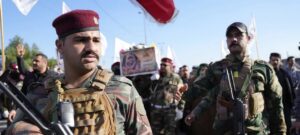 The Shiite militias in Iraq, part of the larger Islamist Resistance Axis, are not as unified and obedient to Iranian directives as commonly assumed.
The Shiite militias in Iraq, part of the larger Islamist Resistance Axis, are not as unified and obedient to Iranian directives as commonly assumed.
How did the militias in Iraq become so powerful? Iraq is firmly in the grip of militias that have been attacking US military positions for months. What role do these armed groups play in the Middle East conflict, and what motivates them? It is a new phase in the escalating spiral between pro-Iranian militias in Iraq and US forces: With the killing of three US soldiers by Iraqi militiamen at the end of January, this escalation seems to have reached a new high. But how did it come to this?
There are dozens of militias, or armed groups, in Iraq. Their power is closely linked to the country’s history. Today, they are even considered to be the real puppeteers in Iraq, a state within a state, explains Inna Rudolf. She works at the “Center for International Radicalization” at the British King’s College and has been researching militias in the region for years.
“The pro-Iranian militias in Baghdad have successfully infiltrated the administration of the Iraqi state. In addition, friends, allies, and agents of these militias then exert influence in all three branches – the executive, legislative, and judicial,” says Rudolf.
Fight against ISIS
Most militias have earned their popularity decades ago through armed resistance against Iraqi dictator Saddam Hussein. Because he suppressed the Shiites – a religious group in the country – for decades, imprisoning or killing many Shiite Iraqis. As a result, many fled to neighboring Iran, where some of them were trained and armed as fighters.
The Shiite fighters solidified their “heroic status” in their fight against the terrorist organisation “Islamic State” (IS). During this time, the so-called Hashd al-Shaabi, which means “Popular Mobilization Units,” were declared. It is a kind of umbrella organization comprising more than 60 predominantly Shiite militias that have spearheaded the bloody fight against IS in recent years.
Officially, the Hashd al-Shaabi are now part of the Iraqi armed forces and follow the direct command of Prime Minister Mohammed Shia’ al-Sudani. However, in reality, most of the approximately 60 militias operate outside official command structures.
“The Americans are not doing anything good for us Arabs”
To understand what drives the militias, one must go to Sadr City – a district in northern Baghdad firmly under the control of the militias. The simple concrete buildings along the large dusty streets are often not even plastered. Illegal gasoline is sold in plastic bottles on many street corners.
For Western journalists, it is dangerous to openly speak with residents or members of the militias here. That’s why we meet Abu Zeinab in a smoke-filled back room of a small cafe. “Basically, the Americans are not doing anything good for us Arabs. I’m telling you, the Americans are the devil in this world,” he says.
The 46-year-old is part of the Harakat Hezbollah al-Nujaba militia, just like the pro-Iranian commander killed by the US in January. Abu Zeinab is not wearing a uniform for the interview but is dressed inconspicuously – blue jeans and a dark jacket. “God willing, the Americans will withdraw from Iraq under our pressure and drone attacks,” he says. These attacks are their right. “We are not subject to any control. We are an independent country.”
The proximity to Iran
Between early October and the end of January, US positions in Iraq, Syria, and Jordan were attacked with rockets or drones more than 160 times – controlled by militant groups. Experts believe that Iran provides political, financial, and above all, military support to many of these Iraqi militias.
Abu Zeinab also confirms the proximity to Iran: “Most of our leaders have lived in Iran for 15 or 20 years. They have eaten, drunk, and lived like Iranians. Iran is our supporter.” He says it has become “the source of resistance for many” and that “it is Iran that supports the resistance forces in the region.”

